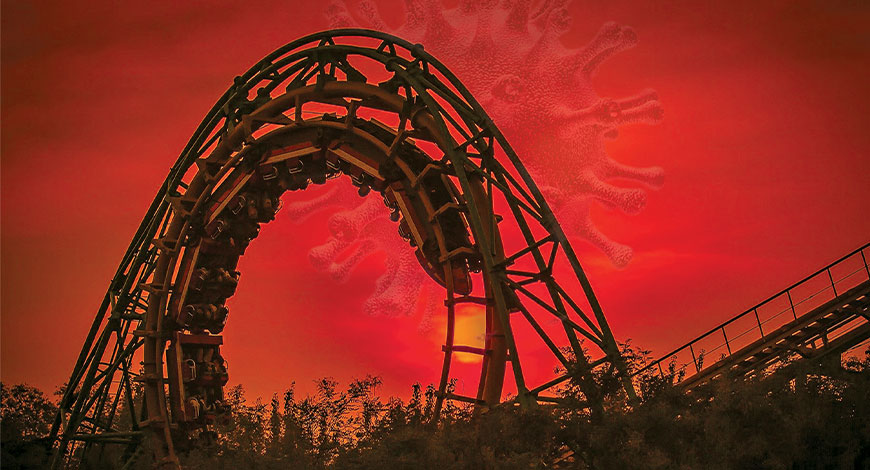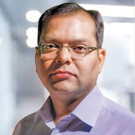COVID-19
A roller coaster ride indeed!

It is not just a case of shut factories and no demand. For products where huge orders were placed, the story is no different.
The COVID-19 pandemic is an evolving public-health and economic crisis. While the worst seems to be behind us in many areas of the United States, Europe and Asia, the Center for Disease Control (CDC) has warned that there may be a second wave in the fall/winter.
India, on the other hand is likely to see a wave of peaks in COVID-19 cases across the country instead of one single high, with coronavirus spreading at a different pace in most states. Different are expected to should have different progressions, and they will not be in step with each other. There is also a high possibility that there are 10 times more cases in India than reported.
As COVID-19 infections increase, the concern on shortage of life-saving equipment and other essential supplies to prevent the spread of the virus and care for the sick also broadens. Medical infrastructure to ensure quality treatment of the admitted patients is being continuously augmented across the country.
As a result of concerted efforts, the COVID-19 hospital infrastructure to treat COVID-19 is stronger today. India has 1383 dedicated COVID-19 hospitals, 3107 dedicated COVID-19 healthcare centers, and 10382 COVID-19 care centers. Together, this amounts to a capacity of 46673 ICU beds. 21848 ventilators are deployed in the hospitals in all states and UTs.
Hospitals operated by corporates too are making massive investments for new equipment, air conditioning and introduction of HEPA filters. ICUs and CCUs were rearranged to address the distance requirements. A 500-bed hospital is likely to incur an additional expenditure of approximately Rs 10 crore toward covid-19 related expenditure. Out of this, Rs 5–6 crore is spent for civil costs related to fever clinics, sanitization tunnels, negative isolation zones, and operation theaters with dedicated air-handling units, and specialized RT-PCR testing equipment for laboratory, etc. And the remaining investment is for operational expenses of these units.
It has been a roller coaster ride for the medical supplies industry. With OPD facilities shut in hospitals for three or more months, there has been a drastic reduction in the uptake of medical devices, for new purchases and replacement equipment. Discretionary, elective procedures in hospitals has as yet not picked up pace. With a 50–70 percent drop in revenue, the government’s push to reserve hospital beds for COVID-19, alongwith the imposition of price caps on treatment, it has not been an easy ride.
Private laboratories, with abysmally low non-COVID test volumes, and having to adhere to the financially unviable price of Rs 4500 for a COVID-test for so long are struggling. Clinical trials for diseases other than COVID-19 remain almost suspended.
Shifting goalposts
The experience in supplying equipment, specifically for COVID-19 too has not been without controversy.
Pulse oximeters
There has been a growing demand for pulse oximeters. For instance, between May-end and June 25, Flipkart witnessed a nearly 12-time increase in demand for this product. Brands reported four times their usual monthly sales. The demand is higher from states where the pandemic has hit hardest, like Maharashtra, Delhi-NCR, Tamil Nadu, and Gujarat. Prices also skyrocketed, MRPs doubled and wholesale prices hiked up 10–20 percent.
Masks
Now that there is enough supply of face masks, after 100 days of the imposition, they are out of the purview of Essential Commodities Act, 1955.
In January, the authorities had also banned export of all types of face masks. In May, non-medical/non-surgical masks of all types could be exported. The industry has now requested to lift the ban on export on the remaining masks too, so that the Indian manufacturers could clear unsold inventories and resume production at full capacity. For three-layer masks, the surplus capacity is 532.03 million, for four-layer it is 1.9 million, and for N95 it is 1.05 million. The manufacturers had ramped up their production lines since the outbreak began.
In any case, The Director General of Health Services has declared that the use of valved respirator, N-95 mask, is detrimental for preventing the spread of coronavirus because it does not prevent the virus from escaping out of the mask. While the masks filter in air that the user inhales, the valves help release exhaled air back into the environment.
It was first found by the Tata Institute of Fundamental Research, Mumbai, that apart from the established manufacturers, such as 3M and Magnum Health & Safety, most of the masks were nowhere close to N95, as their manufacturers claimed. These poor-quality masks filtered only 60–80 percent of 0.3-micron particles, putting healthcare workers at risk of infection. Also, they cannot be washed, as most use electrostatic charge to trap small particles, which lose the charge when washed.
In the past three months, almost 150 manufacturers have come up, most being counterfeiting brands. To rein in these errant manufacturers, it is suggested that CDSCO make it mandatory for the manufacturers to comply with the requisite quality standards, such as IS:9473, developed by BIS. At the moment, it is however not possible as there are not enough external laboratories in which the products could be routinely tested.
Ventilators
The ventilator manufacturers have had a harrowing time. In March, just after India was hit by COVID-19, it was estimated that India would need at least 75000 ventilators till June, against 19398 units available in the country then. The PM CARE Fund allotted Rs 2000 crore, and HLL set out to procure 60884 ventilators, with unit prices ranging from Rs 150000 to Rs 400000, to be supplied by end-June. Orders were placed for 59884 ventilators on domestic manufacturers and overseas manufacturers to the tune of 1000 units. The major domestic players included Skanray (in collaboration with Bharat Electronics Limited) for 30000 ventilators, AgVa (in collaboration with Maruti Suzuki Limited) for 10000 ventilators, AP Medtech Zone for 13500 ventilators and Allied Medical for 350 machines.
The auto industry, PSUs, and defense laboratories were invited to contribute to ventilator supplies. In turn, the regular manufacturers enhanced their production capacities. Ventilator capacity went up from about 300 units per month and eight manufacturers to over 30000 units from 16 manufacturers. For instance, AgVa expanded its manufacturing capacity to 60000 units, Trivitron Healthcare to 60000 units, and Skanray to 120000 units per annum. International players too pitched in. Medtronic open-sourced the design specifications on its portable ventilator, Puritan BennettTM 560.
As COVID-19 progressed, the dynamics changed completely. Ventilators were not the savior as perceived to be earlier. Non-invasive oxygen delivery through nose prongs, using non-invasive ventilation (NIV) or BiPAP mode, was sufficient in most cases. On the contrary, ventilators were found to be harming the patients. Delhi’s COVID-19 committee reported an 85-percent mortality rate among COVID-19 patients who were put on ventilators in the Capital, as did Bangalore Medical College and Research Institute.
There was mayhem as the government went ahead and changed its specifications for ventilator manufacturers, like asking for BiPAP mode and a high-flow nasal cannula with a flow rate of 100 percent. In addition, exports were banned and states were not allowed to buy directly from the makers. Excess stocks piled up with the manufacturers and they inadvertently landed in a major funds crunch.
There were major performance glitches too. Take the case of AgVa, who was awarded the order by HLL for FDA/CE-approved ventilators. The manufacturer delivered 1500 ventilators, unit price being Rs 150000. AgVa is certified by Unitas Certification Services, UK, and has an IEC 60601 compliance certificate from NFI Certifications Ltd, UK, both non-existent entities. As expected, the ventilators, when used at the hospitals failed to boost oxygen to the required levels in critical COVID-19 patients. JJ Hospital and St George’s Hospital in Mumbai returned close to 100 ventilators. The fate of 850 units of Dhaman-1 ventilators manufactured by Jyoti CNC Automation Limited, Rajkot, albeit given free to Ahmedabad Hospital was the same.
Of the 59884 ventilators ordered, as on June 24, only 2923 had been manufactured, partly delayed due to non-availability of critical components on which India is import-dependent, and 1340 ventilators delivered to the states and UTs. The percentage of hospitalized patients on a ventilator has stabilized at 1-2 percent, while 3-4 percent need intensive care.
Oxygen concentrators
Oxygen therapy is crucial to clinical management of patients, especially to keep fatality rates under control. From cylinders to concentrators, the demand for medical oxygen has shot up ever since it emerged as a key element in the treatment of COVID-19.
Supplies are well in place. The daily production of oxygen in the country is 6000 metric tons. Currently, COVID-19-dedicated hospitals and COVID-19 care centers are using 1100-1200 metric tonnes daily.
Earlier, 250-300 concentrators were sold every month, and certain models were available in the price range of Rs 25000-30000. Now, about 40000 pieces of these models are being sold every month with rates up to Rs 75000 each. The rental rates of concentrators have also gone up from about Rs 4500 per month to Rs 6000. While there are strict rules for manufacturing, pricing and storage of cylinders, the market for concentrators is largely uncontrolled and unregulated. However, on June 29, the National Pharmaceutical Pricing Authority (NPPA) directed all manufacturers and importers of oxygen concentrators to submit the MRP being charged.
Data from China shows that about 80 percent patients have mild symptoms or moderate illness, 15 percent need oxygen, and 5 percent will be critically ill, requiring intensive care unit treatment.
Will this segment also go the ventilator way?
Industry Speak
Advancements in clinical chemistry automation
Renoy Roy
Senior Product Executive,
CPC Diagnostics
Automation in clinical chemistry is growing at a faster phase in the IVD industry. Old-generation high-throughput automated analyzers were packed with many features but with large footprint and many proprietary consumables, which made these instruments suitable only for high-volume laboratories.
With technology advancement, now manufacturers are producing high-quality entry-level automated analyzers, with all features suitable for mid- to small-size laboratories. This is a great advantage and opportunity for small-size institutions to automate their laboratories, hospitals, and satellite centers. By automating, challenges faced by manual laboratories, such as manual errors, turnaround time, and limited quality-control management can be eliminated.
- New-generation entry-level automated chemistry analyzers offer features, such as:
- Constant throughput in any combination of tests.
- Increased reagent and sample positions.
- On-board washing of cuvettes.
- On-board cooling for reagents.
- Enhanced QC management.
- System pack reagents guarantee number of tests.
- Capability to perform immunoturbidimetry assay–HbA1C, hCRP, RF, etc.
All these features are incorporated in entry-level automation in a cost-effective manner, with limited number of proprietary consumables, which helps even smaller laboratories to automate.
New-generation instruments are equipped with barcodes for reagent and sample and HIS/LIS connectivity. Integrating instruments with this interface makes the entire lab or hospital fully connected, which drastically reduces the pre- and post-analytical errors. The other major trend is the innovation of software and information technology, which enables remote monitoring that helps in minimizing downtime.
CPC Diagnostics has been offering solutions for chemistry automation for more than 20 years, through new-generation instruments suitable for high, mid, and small laboratories, with excellent after-sales support and remote-diagnostics facilities.
Second Opinion
Delivering oxygen therapy
Dr Divya Mulchandani
Intensivist,
SIDS Hospital & Research Centre, Surat
The rising predominance of COPD, combined with the rising geriatric population, is one of the main driving forces in the development of portable oxygen concentrators. They facilitate preserve patients’ quality of life and reduce healthcare costs related to this chronic disease. The vast majority of the portable oxygen concentrators use the pressure swing adsorption technology, which isolates explicit gases from a blend of gases under strain. In terms of the delivery system, the market has been fragmented into continuous flow and pulse flow. Pulse-flow oxygen concentrators are small in size and weight as less as 5 pounds, have a more extended battery life, and are, therefore, ruling the market
As far as end-client, the market has been fragmented into hospitals, homecare settings, and others. The end-client homecare setting portion is relied upon to rule the market in portable oxygen concentrators, and a rising geriatric population is a portion of the elements for the strength of the homecare setting fragment. North America rules the portable oxygen concentrators showcase.
With technological advancements, better oxygen concentrators have come up. For example, in 2018, Caire Inc. propelled another portable oxygen concentrator named the FreeStyle Comfort weighing 5 pounds and has been structured with a bend that leans against the body’s normal form. The gadget is additionally FAA-affirmed for use in business flights.
Oxygen concentrators – A conspectus
Dr Amit Gupta
Sr Consultant and Head, Critical Care,
Bansal Hospital, Bhopal
Industry experts are enthusiastic about the future of portable oxygen and that patients will be able to get hold of even better equipment in the future to make their lives as close to normal as technology can allow. Portable oxygen technology is continuously evolving and improving, with oxygen concentrators at the core of it.
This is greatly boosted by the increasing demand for these devices, which in turn has been driven by a surge in the number of patients requiring long-term oxygen therapy, e.g., patients with interstitial lung diseases, cystic fibrosis and pulmonary hypertension, rising prevalence of COPD owing to rising environmental pollution, and changing lifestyles, for example, expanded smoking, asthma, and sleep apnea requiring oxygen therapy, improved availability, increased affordability, and the presence of favorable government initiatives are the major factors supporting the market growth. On the flip side, the stringent regulatory scenario is anticipated to impede market growth in coming years.
The oxygen concentrators market has been broadly segmented into product, technology, and end-user.
Customers and healthcare providers prefer portable concentrators over stationary oxygen concentrators, as portable concentrators are lighter in weight, thus facilitating ambulatory management.
Pulse-flow oxygen concentrators intermittently administer a volume of oxygen in milliliters per breath, while in continuous-flow oxygen concentrators, the volume of oxygen delivered is estimated in liters per minute. Pulse-flow oxygen concentrators are lighter, smaller, vitality proficient, and they have more extended battery life when contrasted with continuous-flow oxygen concentrators.
Home oxygen concentrators facilitate convenience and make it easier and safer for the patient to complete their day-to-day activities, which is likely to support the dominance of the homecare segment during the next six years.
Furthermore, oxygen concentrators are now digitally connected to a monitor and ensure the efficient functioning of the system. USB connection and cloud-based network connection are a few advancements in the technology. In addition, devices with a pulse dose as well as continuous-flow mode are now available to eliminate purchasing of two separate devices.
Unusually, high demand for mechanical ventilators is resulting in a significant shortage of these devices in key countries affected by the COVID-19 outbreak. The unmet demand for mechanical ventilators is forcing biomedical engineers and scientists to create makeshift ventilators, using respiratory devices, such as positive airway pressure (PAP), manual resuscitators, nebulizers, oxygen concentrators, and others. This is acting as a pivotal factor for the growth of the oxygen concentrators market in the year 2020 owing to the sudden outbreak of COVID-19 across the world to combat this pandemic.












